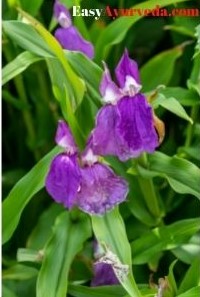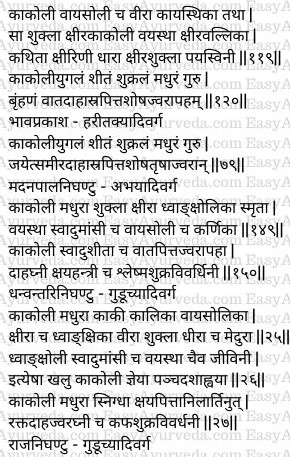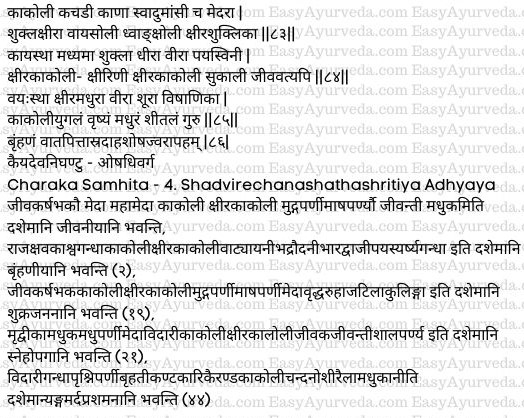Kakoli (Roscoea purpurea) Uses, Medicinal Qualities, Remedies, Research
By Dr Renita D’Souza
Kakoli is an Ayurvedic rhizomatous herb, best known for its aphrodisiac and nourishing activity (balya). It is used in preventing age related problems and best remedy in body debility, impotency, arthritis, burning sensation, inflammation, urinary problems, fever, diabetes, hypertension and other diseases pertaining to Vata and pitta doshas. Root tuber of kakoli act as a good immuno-modulator.
Botanical Name – Roscoea purpurea
Family – Zingiberaceae
Synonyms – Roscoea purpurea f. alba, Roscoea purpurea var. gigantea
Read – Rasna Pluchea lanceolata, Vanda roxburghii, Alpinia galanga Uses, Research

Table of Contents
Medicinal Qualities
Taste – Sweet
Virya – Cold – Sheeta
Vipaka (taste after digestion) – Sweet
Guna
Guru – heavy for digestion
Snigdha – slimy in nature
Action (Karma)
Shukrala – increases sperm count
Brihmana – provide nourishment to the body tissues
Sthanyakara – increases breast milk (Galactagogue)
Jivana – enlivening
Vrishya – aphrodisiac
Read – Pomegranate Benefits, Home Remedies, Side Effects
Effect on Tridosha
Kapha vardhana – increases Kapha dosha
Balances Vata and Pitta dosha
Therapeutic Uses
Vata roga – Diseases pertaining to vata dosha
Daha – Burning sensation
Raktapitta – Bleeding disorders
Shosha – emaciation
Jwara – Fever
Kshaya – debility
Part Used
Tuberous root
Sanskrit Verses



Remedies
General debility – Kakoli root powder is consumed with milk added with little quantity of sugar.
Nutritional Values
Sugar 0.29 ± 0.01
Starch 0.84 ± 0.01
Phenolics 0.71 ± 0.005
Flavonoid 0.6 ± 0.01
Protein 3.46 ± 0.01
Alkaloid 2.3 ± 0.01
Oil 3.5 ± 0.005
Fibre 28.1 ± 0.01 (A)
Pharmacological Activity
Antirheumatic, Febrifuge, Galactagogue, Hemostatic, Expectorant, Sexual stimulant, Diuretic and Cooling property.
Botanical Description
Roscoea purpurea is a perennial herb. It grows upto 50 cm in height with stout pseudo stem. Leaves are wide, 5-6 in number, lanceolate, leaf sheath are pale green or may have dark reddish purple tinge. Flowers are purplish/white/reddish in color, arranged in a sessile spike. Roots are straight and curved, dark brown in color. (B)
Distribution
Roscoea purpurea is native of Nepal and widely distributed in Himalaya and Bhutan.
Habitat
Roscoea purpurea is found on steep, grassy hill, damp places and stony slopes.
Chemical Constituents
Roscoea purpurea contains carbohydrates, proteins, phenolics, flavonoids, alkaloids, glycosides, tannin and saponins.
Classical categorization
Bhavaprakasha Nighantu – Haritakyadi varga
Madanapala Nighantu – Abhayaadi varga
Dhanvantari Nighantu – Guduchyadi varga
Raja Nighantu – Guduchyadi varga
Kaiyadeva Nighantu – Oashadi varga
Sushrutha Samhita – Kakolyadi Gana
Charaka Samhita mentioned Kakoli under Jivaniya ghana, Brihmaniya, Shukrajananiya and Snehopaghaniya ghana.
Sanskrit Synonyms
Kakoli, Vayasoli, Vira, Kayasthika,
Madhura – sweet in taste
Ksheera, Payasvini
Shukla
Vayastha – improves life span
Swadu mamnsi, Dwanksholi
Karnika
Research
Immunostimulant Activity – A study conducted to evaluate immunomodulatory activity of ethanolic extract of Roscoea purpurea rhizomes in mice have proved significant immunostimulant activity of ethanolic extract of rhizomes of Roscoea purpurea.
Antioxidant Activity – A study was conducted to evaluate Antioxidant property of the Rhizome Extract of Roscoea purpurea Sm. and its use in green synthesis of gold nanoparticles. The result of the study concluded efficient radical scavenging activity of extract of Roscoea purpurea and hence proved the usage of Kakoli in prevention of free radical related diseases.
Formulations using Kakoli
Chyavanprash
Dhanvantharam Mezhukupaakam – Best used in vata disorders, Puerperal and pediatric diseases.
Shiva Gutika – Used in Liver and spleen disorders, respiratory problems, skin disorders, ascites etc
Prasoothika kashaya – Helps to restore health after delivery (postpartum period)
Phala Sarpi – Used in female infertility
Dashamoolarishtam – Used in anemia, postpartum period, cough, digestive problems etc
Jivanthyadi Ghrita – Used as medicine for Snehakarma, Netra basti and Netra tarpana. Treats glaucoma
Scientific Classification
Kingdom – Plantae
Clade – Tracheophytes
Clade – Angiosperms
Clade – Monocots
Clade – Commelinids
Order – Zingiberales
Family – Zingiberaceae
Genus – Roscoea
Species – R. purpurea (C)
Ashtavargha Dravyas
Kakoli is one among the ingredients of Ayurvedic formulation called Ashtavarga which is mentioned in Bhavaprakasha Nighantu, Haritakyaadi varga 120. The word Ashta means 8 and varga means group. The author has also mentioned Ashtavarga Prahinidi Dravyas, herbs which are used as substitution for Ashtavarha herbs.
Ashtavarga Prathinidi Dravyas
Kakoli – Ashvagandha
Kshirakakoli – Ashvagandha
Jeevaka – Vidarikhanda
Rishabaka – Vidarikhanda
Meda – Shatavari
Maha meda – Shatavari
Riddhi – Varahikadha
Vriddhi – Varahikadha
The above drugs were mentioned as substitution for Ashtavarga herbs due to lack of availability such as Ashvagandha used as substitution for Kakoli and Ksheera kakoli, Vidarikhanda for jeevaka and Rishabhaka, Shatavari for meda and mahameda, Varahikhanda for Riddi and Vriddhi.
Read – Ashtavarga Group Of Herbs Benefits, Research
But nowadays these are not used as substitutes because it is obseved that very less benefits are obtained from Ashtavarga. Hence, Guduchi, Vamshalochana, Salama mishri (Orchis latifolia), Prasarini (Paederia foetida), Kalimusali (Curciligo orchioides Gaertn), Shweta musali (Asparagus adscendens Roxb), Bala bija and Mahabala (Sida rhombifolia Linn) are used as substitutes for Jevaka, Rishabhaka, meda, mahameda, Kakoli, Ksirakakoli, Ridhi, Vridhi respectively. (Click to read more)
Vernacular Names Of Kakoli
English Name – Purple Roscoe Lily
Sanskrit Name – Kakoli
Nepal Name – Rasgari, Bhordaya, Bhui saro, Themmi
Hindi Name – Kakoli
Click here to consult Dr Renita D’Souza










